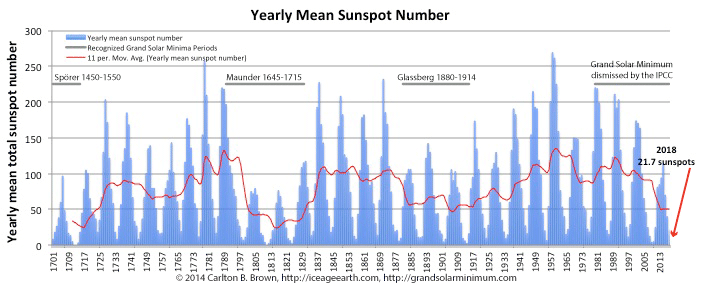Yearly mean sunspot numbers covering Solar Cycles 1-24 between 1700 and 2018. This highlights an approximate 11-year solar cycle duration, and that the peak sunspot number for each 11-year solar cycle vary over longer-term cycles. The peaks and troughs of these longer-term solar cycles are referred to as grand solar maxima and minima respectively.[i] Sunspot numbers during the 11-year solar cycle have been in decline since the late 1980s. Solar Cycle 24 is progressing toward a grand solar minimum in terms of sunspot numbers.
How do solar cycles and grand solar minima arise?
The sun physically oscillates around the solar system’s center of mass on its journey through galactic space. This wobble effect on the solar system’s center of mass is due to the gravitational and angular momentum impact of the giant planets, specifically Jupiter and Saturn. This wobble effect results in a number of periodic oscillations in the movement of the sun about the solar system’s center of mass.[ii],[iii],[iv]
Physical forces operating between the planets as they orbit the sun also affect the rate at which planets rotate, and the sun’s rate of rotation as well. Cycles of differential rotation by the sun are thus established, which then determine the multiple periodicities of the sun’s activity. Earth’s rate of rotation is also subject to these same planetary forces acting on the sun.[v]
This planetary influence on the sun’s motion around the solar system’s center of mass perturbs the sun’s internal solar dynamo processes. The solar dynamo is responsible for generating the sun’s magnetic fields. Cycles of solar activity therefore manifest in sunspots, solar flares, solar irradiance, coronal mass ejections, and the sun’s magnetic fields emanating into space (magnetized solar wind).[vi]
Sunspot numbers rise and fall over an 11-year cycle (see above), and these sunspots can be observed on the surface of the sun as dark discs. The current Solar Cycle 24 began in January 2008.[vii] This is the third 11-year cycle in a row since the peak of Cycle 21 in the late 1980s with diminishing peak sunspot numbers.[viii]
These diminishing peaks and troughs of solar activity highlight the influence of longer-term solar cycles that impact the magnitude of the 11-year solar cycle (sunspot numbers), and indicate that the sun is moving into a grand solar minimum phase. These longer-term cycles include the Gleissberg (50–80 and 90–140 year periods) and Suess cycles (170–260 year periods).[ix] At this stage of the glacial cycle, the sun spends about twice the time in grand solar minima compared with grand solar maxima.[x]
Click on this page and download a free copy of my book “Revolution: Ice Age Re-Entry,” and read more about this topic in Chapter 6.
[i] Sunspot data from the World Data Center SILSO, Royal Observatory of Belgium, Brussels. http://sidc.be/silso/datafiles#total. [Data: Yearly mean sunspot numbers from 1700 to the present. Downloaded 05/05/2018.].
[ii] N.A. Mörner et al., “General conclusions regarding the planetary–solar–terrestrial interaction.” Pattern Recognition Physics, 1, 205–206, 2013. www.pattern-recogn-phys.net/1/205/2013/. doi:10.5194/prp-1-205-2013.
[iii] J.E. Solheim, “The sunspot cycle length – modulated by planets?” Pattern Recognition Physics, 1, 159–164, 2013. www.pattern-recogn-phys.net/1/159/2013/. doi:10.5194/prp-1-159-2013.
[iv] I.R.G. Wilson et al., “Does a Spin-Orbit Coupling Between the Sun and the Jovian Planets Govern the Solar Cycle?” Astronomical Society of Australia, Volume 25, Issue 2, 85-93. DOI:10.1071/AS06018.
[v] R. Tattersall, 2013, “Apparent relations between planetary spin, orbit, and solar differential rotation.” Pattern Recognition in Physics, 1 (1). 199 – 202. https://doi.org/10.5194/prp-1-199-2013.
[vi] Katya Georgieva, “Effects of interplanetary disturbances on the Earth’s atmosphere and climate.” http://www.issibern.ch/teams/interplanetarydisturb/wp-content/uploads/2014/01/proposal.pdf.
[vii] European Space Agency, “SOHO, New Solar Cycle Starts with a Bang.” http://www.esa.int/Our_Activities/Space_Science/SOHO_the_new_solar_cycle_starts_with_a_bang.
[viii] Sunspot data from the World Data Center SILSO, Royal Observatory of Belgium, Brussels. http://sidc.be/silso/datafiles#total. [Data: Based on the Yearly mean sunspot number. The 1980 (1979.5) peak sunspot number was 220, 1990 (1989.5) peak 211, 2001 (2000.5) peak 174, 2015 (2014.5) peak 113. Downloaded 05/05/2018.].
[ix] M.G. Ogurtsov et al., Long-Period Cycles of the Sun’s Activity Recorded in Direct Solar Data and Proxies. Solar Physics (2002) 211: 371. https://doi.org/10.1023/A:1022411209257.
[x] I.G. Usoskin et al., “Grand minima and maxima of solar activity: new observational constraints.” Astron.Astrophys.471:301-309,2007. DOI:10.1051/0004-6361:20077704.

